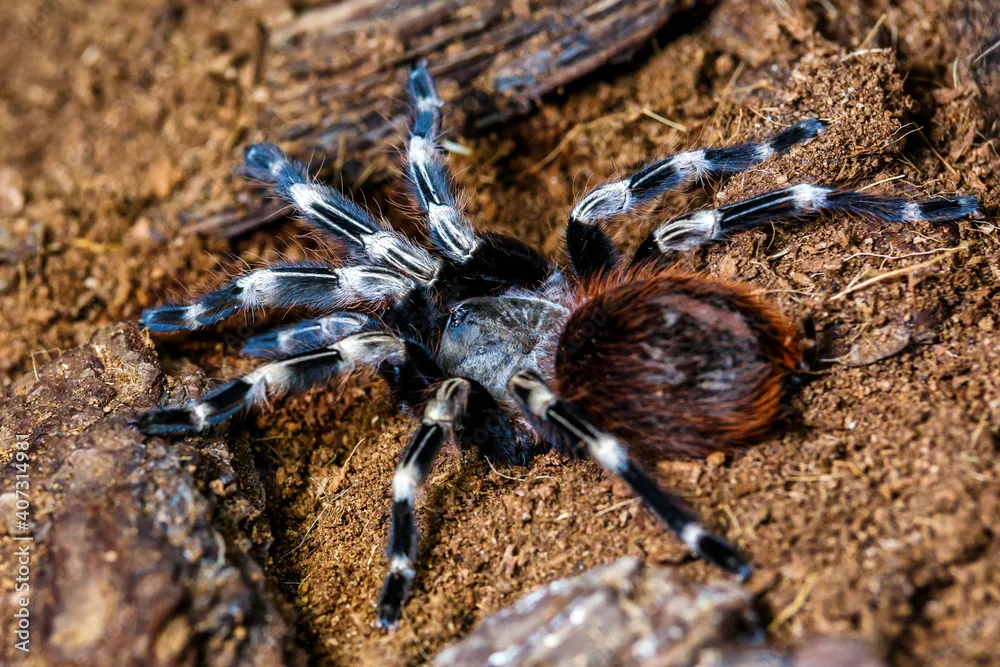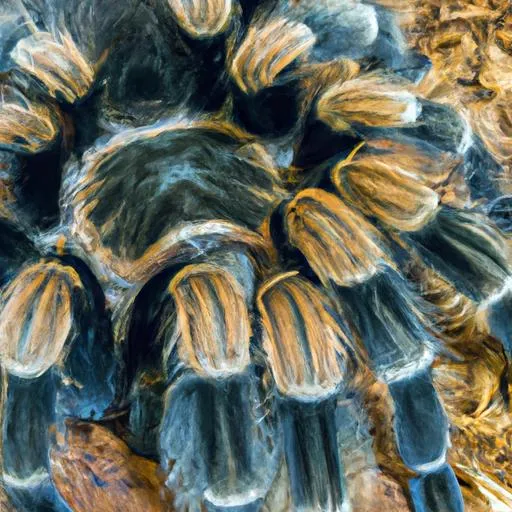What is a Tarantula
Tarantulas are large and hairy spiders belonging to the Theraphosidae family. These impressive arachnids are found in various habitats around the world, primarily in tropical and subtropical regions. Known for their size, distinctive appearance, and, in some cases, venomous bites, tarantulas have captivated the interest of scientists, pet enthusiasts, and the general public alike. Their nocturnal habits and solitary nature often make them elusive, adding to their mystique. Despite their often intimidating appearance, tarantulas play a vital role in their ecosystems as both predators and prey, contributing to the balance of their environments. The name ’tarantula’ is sometimes used to refer to any large spider, but it specifically designates this specific family of spiders.
Tarantula Physical Characteristics
Tarantulas are easily recognizable due to their substantial size and unique physical features. They possess two main body segments the cephalothorax (fused head and thorax) and the abdomen. Their bodies are covered in a dense coat of hairs, which can range in color from brown and black to vibrant hues of orange, red, or blue, depending on the species. These hairs serve several functions including sensory perception and defense mechanisms. Tarantulas also have eight eyes, usually arranged in two rows, providing them with decent vision, particularly for detecting movement. The chelicerae (mouthparts) are powerful and equipped with fangs that deliver venom, used primarily for subduing prey. Their robust legs are covered with hairs and claws, which help them climb, dig, and navigate their environments.
Size and Weight

The size of tarantulas varies greatly among the different species. Some of the largest species can have a leg span of over 10 inches, while others are much smaller. The Goliath birdeater (Theraphosa blondi) is often cited as the largest tarantula species, with the potential to reach leg spans of up to 12 inches. In terms of weight, tarantulas can weigh anywhere from a few grams to over 6 ounces, depending on their size and the amount of food they have consumed. The overall size and weight of a tarantula are significantly influenced by their diet, age, and the environmental conditions in which they live.
Leg Span
The leg span is a key measurement used to compare the size of different tarantula species. This measurement is taken from the tip of one leg to the tip of the opposite leg when the spider is fully stretched out. The leg span is a more practical and readily available measurement than body length or weight when identifying and comparing tarantula sizes. The leg span provides a clear indication of the overall size and reach of the spider, affecting its ability to capture prey and navigate its surroundings. The Goliath birdeater has the largest average leg span, although individual measurements can vary among different specimens.
Habitat and Distribution
Tarantulas inhabit a diverse range of environments across the globe, with the greatest diversity found in tropical and subtropical regions. They are native to the Americas, Africa, Asia, and Oceania. Within these regions, they have adapted to various habitats, including rainforests, grasslands, deserts, and even mountainous areas. The distribution of tarantulas is often influenced by factors such as climate, prey availability, and the presence of suitable shelter, such as burrows or dense vegetation. Their ability to thrive in a variety of habitats showcases their adaptability and resilience as a species. They are usually found in warmer climates, as they require specific temperature and humidity to survive and thrive.
Where They Live

Tarantulas can be found in a wide array of locations, from underground burrows to trees and shrubs. Many species are terrestrial, meaning they live on the ground, while others are arboreal, preferring to live in trees or high above ground. Terrestrial tarantulas often construct burrows in the soil, lined with silk to provide stability and protection. Arboreal tarantulas may reside in crevices, under the bark of trees, or among dense foliage. Some species even create silk retreats amongst the leaves. Their choice of living space depends on their specific needs, including the availability of food, the level of protection from predators, and the environmental conditions of their habitat.
Types of Habitats
The types of habitats tarantulas occupy are as diverse as the species themselves. Rainforests provide ample humidity and a wealth of insect prey, supporting large populations of tarantulas. Grasslands offer open spaces and ground-dwelling insects that serve as food. Deserts, although harsh, are home to specialized tarantula species that have adapted to survive in arid conditions. The presence of microhabitats, such as rock crevices, fallen logs, and leaf litter, provides shelter and helps them regulate their body temperature. The choice of habitat also depends on the tarantula’s lifestyle terrestrial or arboreal. Their survival depends on their adaptation to these diverse environments.
Diet and Feeding Habits
Tarantulas are primarily carnivorous predators, with their diet consisting mainly of insects, but also including small vertebrates such as lizards, frogs, and even small birds, depending on the species and size of the tarantula. They are opportunistic hunters, meaning they will consume whatever prey they can subdue. The diet of tarantulas varies with their geographic location and the types of prey available. They play a crucial role in the food chain, helping to control insect populations and providing a food source for larger predators. Juvenile tarantulas typically eat smaller insects like fruit flies and crickets while adult tarantulas consume a wider range of prey.
What Tarantulas Eat

The diet of a tarantula is diverse. Insects, such as crickets, cockroaches, mealworms, and beetles, constitute the primary food source for most species. Larger tarantulas may also consume small vertebrates such as mice, lizards, and even small snakes. The size of the prey usually depends on the size of the tarantula. They use their powerful chelicerae (mouthparts) to inject venom into their prey, which paralyzes them and begins the process of breaking down the prey’s tissues. They then consume the liquefied remains of their prey. The nutritional needs and the availability of food sources shape the tarantula’s feeding habits.
Hunting Techniques
Tarantulas use a variety of hunting techniques depending on their species and the environment. Some are ambush predators, waiting patiently in their burrows or hiding places until prey comes within striking distance. Others actively hunt, stalking their prey and ambushing them. They possess sensitive hairs on their legs called setae that detect vibrations in the ground and air. This helps them identify and locate potential prey. When a tarantula senses movement, it quickly strikes, injecting venom to immobilize the prey. The entire hunting process happens swiftly, with the tarantula’s survival depending on its ability to capture a meal efficiently.
Tarantula Behavior and Life Cycle
The behavior and life cycle of tarantulas are fascinating, encompassing aspects of their lifespan, molting process, and reproductive habits. Tarantulas are generally solitary creatures, except during mating season. Their lifespan varies greatly among species, with females often living much longer than males. They grow through a process called molting, shedding their exoskeleton to allow for growth. The life cycle from egg to adult can take several years, depending on the species. The intricate details of their behavior contribute to their survival and their place in their ecosystem. They are mostly nocturnal, which is a behavior that helps them avoid predators and hunt more efficiently.
Lifespan

The lifespan of a tarantula is highly variable and depends on its species, with females generally living much longer than males. Female tarantulas can live for 10 to 30 years or more, particularly in some larger species, while males typically live for only a few years, often dying shortly after mating. The longevity of females is due to factors such as their role in reproduction, their slower metabolism, and their ability to avoid the risks associated with mating behavior. The difference in lifespan between males and females is a significant aspect of their life cycle, with males often living only long enough to mate and spread their genes.
Molting Process
Molting is a crucial process for tarantulas, allowing them to grow and replace their exoskeleton. As a tarantula grows, it sheds its old exoskeleton, revealing a larger, softer body beneath. The frequency of molting depends on the age and growth rate of the tarantula, with younger individuals molting more often than adults. During molting, the tarantula is highly vulnerable, as it cannot move quickly or defend itself. The process can take several hours or even days, during which time the tarantula is defenseless. This process is essential for their growth and development. After molting, the tarantula’s new exoskeleton hardens, and it resumes its normal activities.
Amazing Tarantula Facts
Tarantulas hold several amazing secrets, and here are the top 5 most amazing facts that showcase their fascinating characteristics. From their unique defense mechanisms to their extraordinary hunting skills, these facts highlight the adaptations that have allowed them to thrive for millions of years.
Amazing Discovery 1

Some tarantula species possess urticating hairs. These are specialized hairs on their abdomen that they can flick at potential threats. These hairs are highly irritating to the skin and eyes, serving as a defense mechanism against predators. This behavior is a unique adaptation. When threatened, the tarantula uses its hind legs to brush off these hairs, creating a cloud that irritates the attacker, allowing them to escape.
Amazing Discovery 2
Tarantula venom, while not usually fatal to humans, contains a complex mix of toxins. The venom of tarantulas contains a range of proteins and peptides that can cause localized pain, muscle cramps, and other symptoms. Research into these toxins is ongoing, with scientists exploring their potential use in medicine. The study of tarantula venom offers exciting possibilities for the development of new treatments for pain management, and other medical conditions.
Amazing Discovery 3
Tarantulas have remarkable regenerative abilities. If a tarantula loses a leg, it can regenerate a new one over several molts. This ability is a survival advantage, particularly in the wild, where injuries are common. The process of regeneration involves the growth of a new limb from the stump of the old one, which takes several molts to fully develop. This regenerative capacity sets them apart from many other animals and contributes to their long-term survival.
Amazing Discovery 4

Tarantulas exhibit complex courtship rituals. During mating season, male tarantulas engage in elaborate displays to attract females. These displays often involve drumming their pedipalps or legs on the ground, producing vibrations that the female senses. The male will also build a sperm web to deposit his sperm. If the female accepts the male, he will use his pedipalps to insert the sperm into her reproductive organs. This behavior is part of a careful process that ensures the perpetuation of the species, with males often risking their lives during the mating process.
Amazing Discovery 5
Tarantulas have been around for millions of years. Fossil records show that tarantulas existed during the Jurassic period, making them ancient creatures. They have adapted to changing environments, demonstrating their resilience and evolutionary success. The fact that they have survived through the ages highlights their adaptability and remarkable ability to thrive in diverse conditions. This ancient lineage makes them fascinating subjects for scientific study.
Conclusion
Tarantulas are truly amazing creatures. They are not only interesting but play a vital role in their ecosystems. Their unique characteristics, adaptations, and behaviors continue to fascinate scientists and enthusiasts alike. From their impressive size and diverse habitats to their intricate life cycles and defense mechanisms, tarantulas offer a glimpse into the wonders of the natural world. As we learn more about these incredible spiders, we gain a greater appreciation for their importance and the need to protect their habitats. They are a crucial part of our world.
